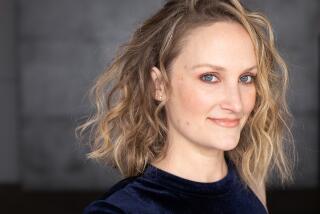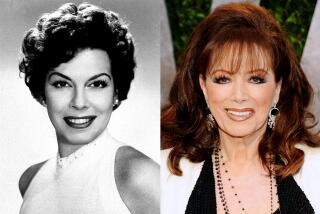‘Valley of the Dolls’ Retains Its Chemistry
- Share via
Scientific researchers haven’t yet proved that brain cells melt in the summer sun. But is empirical evidence really necessary to explain the perennial popularity of beach books, or pool novels, or whatever term publishing industry marketers conjure up to describe trashy entertainments as addictive as M&Ms;?
Did I say addictive? Yes. As habit-forming as Percodan, the What, Me Worry, mood-elevating painkiller. Or Valium, the Chanel of sedatives, simultaneously modern and classic.
How do I, a pharmaceutical ascetic whose idea of rehab is switching to caffeine-free Diet Coke for a month, know so much about better living through chemistry? Because, like many American teenagers, I discovered that babysitting provided seclusion plus access to the naughty section of a suburban family’s private library. There, down the shelf from “Catch-22” and James Michener’s “Hawaii,” an intrepid explorer could usually find well-worn copies of “Peyton Place,” something tasty from the Harold Robbins oeuvre and, wrapped in a stark, white jacket scattered with an array of colored pills (or dolls, to the initiated)--”Valley of the Dolls.” Although the fans of “Valley of the Dolls” maintain its appeal is timeless, a long-awaited sequel has just been published.
Jacqueline Susann’s pulp fiction marvel came out in 1966, a simpler time, when fat-free Oreos hadn’t been invented and adolescents didn’t learn about oral sex from the nightly news. Susann’s saga of three young women whose dreams of true love and success went south on a river of alcohol and prescription pills provided more than one generation with a beginner’s manual on sex, adultery, lesbianism, drugs, abortion and the perils of getting what you wish for.
Doesn’t that sound like fun? It was. So much good, bad fun that the book was made into a movie that became a camp classic, stayed on the bestseller list for 65 weeks, and has sold around 30 million copies to date. The author died of breast cancer in 1974, at 56. Her only child was an autistic son who spent his life in institutions. Her late husband’s stepdaughter, Lisa Bishop, became the manager of Susann’s literary estate and keeper of the flame. She inherited a smashing collection of Pucci scarves, original “Valley” posters and the first draft of an unfinished sequel.
The lives of beach book characters play in a loop that travels from despair, rebirth and triumph round the bend to excess and back home to obscurity. Bishop believed that model Anne Welles, singer-actress Neely O’Hara and agent/studmuffin Lyle Burke, the unholy trinity still standing at the end of “Valley,” could go one more lap.
The novel had been out of print for 16 years, but when a pink-covered paperback edition was reissued in 1997, it sparked a Susann revival. Bishop found a publisher who agreed that an authorized “Valley” sequel was worth doing, and the search for a writer who’d share a dust jacket with Susann began.
Which is why I’m sitting in the Polo Lounge, swapping memories of pubescent reading experiences with Rae Lawrence, the woman who turned 200 pages of Susann’s rough notes into “Shadow of the Dolls,” (Crown, $22.) Our location is strategic for someone in the business of channeling Susann’s spirit; the Beverly Hills Hotel was one of the flamboyant author’s hangouts.
Lawrence, 45, doesn’t remember the first time she read “Valley” or how many times she reread it growing up in New Jersey, but eventually her paperback copy fell apart. “My memory was that it was so much about sex and pills,” she says. “When I went back to it, I realized it’s about more than that-- ambition, friendship, how people want everything and it’s never enough, and they want more, more, more, more, and then when they get it, are they satisfied? And the bargains people make. Those are the great themes. The themes of Flaubert. The stuff we all think about.”
Now, wait a minute. Some people think about how to get their washable whites whiter, or how to pay college tuition bills. Most will never have to wrestle with the discontent that can surface once life’s pinnacle has been reached.
“That’s true,” Lawrence concedes. “You and I don’t have to worry about being stalked by a National Enquirer photographer on our way out of the doughnut shop.”
I can forgive Lawrence’s slip and her literary name-dropping. After all, she spent two years writing “Shadow of the Dolls,” immersed in a world in which “men smell like lime cologne, sandalwood soap, unfiltered cigarettes and taste of cinnamon mouthwash.”
Not only does she come by that Flaubert reference honestly--she was a literature major at Radcliffe--but she also smiles broadly when she says it. She wrote “Satisfaction” 15 years ago, a bestseller that demonstrated her command of the genre she calls “pop.” She enjoys everything about the form, from choosing a pen name to getting to call watching “E! True Hollywood Story” research.
“Naming characters is the fun part,” she says, “starting with yourself.” Her real name is Ruth Liebmann, although Rae is an old nickname. Rae writes books in the catty voice of a third wife dumped the day before a pre-nup expires. Ruth works in the sales department at Random House in New York and won’t dish about other pop writers. “God bless everyone who figures out how to finish a novel and get it published,” she says. “I guess I consider my real competition to be the mall. On a Saturday afternoon, people can decide to read a book or go shopping.”
Lawrence and her alter-ego agree that the fundamental things apply, as time goes by. “I think people still lie about pills and sex. They pretend they’re having it when they’re not, and pretend they’re not having it when they are. That’ll never change.”
When last we met the “Valley” characters, it was the late ‘60s. With the God-like self-assurance of a plastic surgeon, Lawrence reintroduces them in the late ‘80s as only 10 years older. She updates the haunts of the beautiful people. “The Hamptons is now a celebrity hot spot, but in Jackie Susann’s day, it was pretty much one big potato farm,” she says. And she honors the pop fiction convention of offering characters who are thinly disguised stand-ins for Katie Couric, Ted Turner and other stars of the money-media-technology-entertainment nexus.
Most “Valley” readers thought that Neely O’Hara was based on Judy Garland and that Jennifer North, the tragic beauty who died in the book, was a Marilyn Monroe clone. “If you watch ‘Mysteries and Scandals’ or VH1’s ‘Behind the Music,’ every week there’s a person who could be Jennifer North,” Lawrence says. “The Judy Garland story happened to a lot of other people. Maybe on a smaller scale, but it’s not unique to her.
“There are only so many ways people get chewed up by life. If you want to write characters who crash and burn, there’s an embarrassment of riches out there. So long as the pharmaceutical companies are still in business, there’ll be no shortage of material.”
More to Read
Sign up for our Book Club newsletter
Get the latest news, events and more from the Los Angeles Times Book Club, and help us get L.A. reading and talking.
You may occasionally receive promotional content from the Los Angeles Times.








